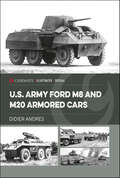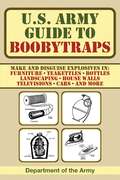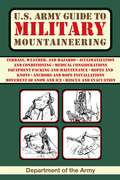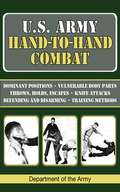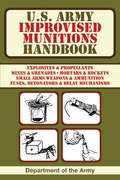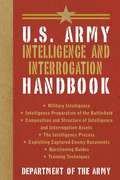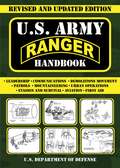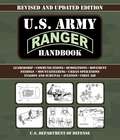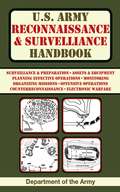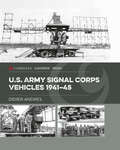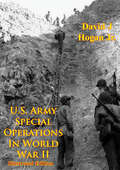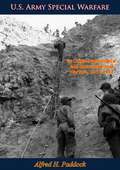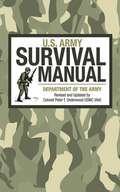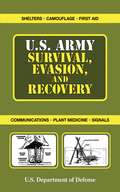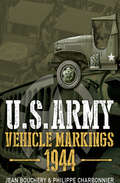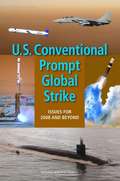- Table View
- List View
U.S. Army Ford M8 and M20 Armored Cars
by Didier AndresFinalist, 2023 Army Historical Foundation Distinguished Writing Awards The M8 and M20 served in Europe and the Pacific during WWII. Author has used the archived notes of the officer tasked with coordinating the project to develop and deliver the M8, explaining why it took two years to deliver it to the Army. Over 200 photographs make this a great reference for any military modeler or vehicle enthusiast.
U.S. Army Guerrilla Warfare Handbook
by ArmyThey can be swift, silent, and deadly. That's why armed guerrillas are feared by even the largest, best-equipped fighting forces. No tank, rocket-propelled grenade, or infantry battalion can match the guerrilla team's ability to exact brutality with precision, instill fear in enemy hearts, and viciously deflate morale. From the snows of Korea to the jungles of Southeast Asia to the mountains of Afghanistan, the U.S. Army has employed guerrilla tactics to deadly effect. Those tactics and techniques, being used today by U.S. soldiers, are laid out in the U.S. Army Guerrilla Warfare Handbook. Employing small, heavily-armed, and well-oiled fire teams, guerrilla warfare has played an invaluable role in the success of nearly every U.S. campaign for decades. Here, its methods are detailed: raids and ambushes, demolition, counterintelligence, mining and sniping, psychological warfare, communications, and much more. This is an inside look at the guerrilla strategies and weapons that have come to be feared by enemies and respected by allies. Not another outside perspective or commentary on unconventional warfare, this is the original--of use to soldiers in the field and to anyone with an interest in military tactics.
U.S. Army Guide to Boobytraps: Make And Disguise Explosives In - Furniture - Teakettles - Bottles - Landscaping - House Walls - Televisions - Cars - And More
by ArmyLittle is more dangerous to U.S. forces fighting insurgents in hot spots around the world than improvised explosive devices. It’s the weapon of choice for under-funded forces aimed to attack American soldiers with low risk to themselves. This official U.S. manual is the complete guide to using and dismantling boobytraps. Here you can learn how to assemble, use, detect, and remove boobytraps and demolition items in almost any situation. With intricate and detailed diagrams, you’ll discover how army troops can disguise boobytraps in household items such as irons, teapots, and televisions; in structures such as window frames, stairways, and wooden beams; and in outdoor areas, in bushes and underground. Find out how boobytraps work, why they are used in the army, and the tactics behind their set-up. Learn the mechanics of the various types of firing devices, detonators, fuses, cords, adapters, blasting caps, and lighters. Also included are detailed instructions for detecting and removing boobytraps. The U.S. Army Guide to Boobytraps explains the responsibilities and safety issues that should be thoroughly understood by anyone using any weapon. Any military enthusiast will appreciate the level of detail this field manual offers.
U.S. Army Guide to Military Mountaineering (US Army Survival)
by ArmyMountains exist in almost every country in the world and almost every war has included some type of mountain operations. This pattern will not change, and soldiers will continue to fight in mountainous terrain in future conflicts. Although mountain operations have not changed, several advancements in equipment and transportation have increased the soldiers' capabilities. The helicopter now allows access to terrain that was once unreachable or could be reached only by slow methodical climbing. Inclement weather, however, may place various restrictions on the capabilities of air assets available to a commander. The unit must then possess the necessary mountaineering skills to overcome adverse terrain to reach an objective.The U.S. Army Guide to Military Mountaineering details techniques soldiers and leaders must know to cope with mountainous terrain. These techniques are the foundation upon which the mountaineer must build. They must be applied to the various situations encountered to include river crossings, glaciers, snow-covered mountains, ice climbing, rock climbing, and urban vertical environments. The degree to which this training is applied must be varied to conform to known enemy doctrine, tactics, and actions. This guide also discusses basic and advanced techniques to include acclimatization, illness and injury, equipment, anchors, evacuation, movement on glaciers, and training.
U.S. Army Hand-to-Hand Combat: Training - Ground-fighting - Takedowns And Throws - Strikes - Handheld Weapons - Standing Defense - Group Tactics (US Army Survival)
by ArmyIn close-quarter combat, there is no second chance and no room for error. On the street, as in military combat, even the smallest mistake can make the difference between life and death. U.S. Army Hand-to-Hand Combat is the official field manual (FM 21-150) used by U.S. Army soldiers-men and women trusted, trained, and tasked to protect the United States from enemies in every kind of situation. From a rundown of training methods to essential information about throws, holds, escapes, knife attacks and more, it covers every tactic and scenario clearly and thoroughly. When weapons are unavailable or not advisable, the techniques in this manual will show every reader the skills necessary to neutralize an attacker swiftly and effectively.
U.S. Army Improvised Munitions Handbook: Explosives & Propellants, Mines & Grenades, Mortars & Rockets, Small Arms Weapons & Ammunition Fuses, Detonators, & Delay Mechanisms (US Army Survival)
by ArmyYou don’t need to be a trained soldier to fully appreciate this edition of the U.S. Army Improvised Munitions Handbook (TM 31-210). Originally created for soldiers in guerilla warfare situations, this handbook demonstrates the techniques for constructing weapons that are highly effective in the most harrowing of circumstances. Straightforward and incredibly user-friendly, it provides insightful information and step-by-step instructions on how to assemble weapons and explosives from common and readily available materials. Over 600 illustrations complement elaborate explanations of how to improvise any number of munitions from easily accessible resources. Whether you’re a highly trained solider or simply a civilian looking to be prepared, the U.S. Army Improvised Munitions Handbook is an invaluable addition to your library.
U.S. Army Intelligence and Interrogation Handbook: The Official Guide On Prisoner Interrogation (US Army Survival)
by ArmyThe U.S. Army Intelligence and Interrogation Handbook provides doctrinal guidance, techniques, and procedures governing the use of interrogators as human intelligence collection agents in support of a commander's intelligence needs. It outlines the interrogator's role within the greater intelligence effort as well as the unit's day-to-day operations, and includes details on how interrogators accomplish their assigned missions. This handbook is intended for use by interrogators as well as commanders, staff officers, and military intelligence personnel charged with conducting interrogations, and applies to operations at all levels of conflict intensity, including conditions involving the use of electronic warfare or nuclear, biological, or chemical weapons.The U.S. Army Intelligence and Interrogation Handbook builds upon existing doctrine and moves interrogation into the twenty-first century within the constraints of the Uniform Code of Military Justice and the Geneva Conventions. Principles, guidelines, and topics covered include:The definition of interrogationInterrogator capabilities and limitationsWarfighting doctrineThe intelligence cycle, and its disciplines and operationsAmphibious and airborne operationsThe interrogation processExploiting captured enemy documentsA tactical questioning guideAnd many more tactics and techniques used by the U.S. Army!
U.S. Army Ranger Handbook (Us Army Survival Ser.)
by ArmyThis handbook offers the techniques and tactics that make Army Rangers the best soldiers in the world. These highly-trained, easily-deployable, and widely-skilled infantrymen specialize in airborne assault, raids, recovery of personnel and equipment, and airfield seizure, among other difficult and dangerous missions. Drawing from over two centuries of bloody lessons learned in special operations combat, this guide gives modern soldiers the best advice possible. In straightforward language and a no-frills style, it covers deception, stealth, communications, escape and evasion, ambush operations, perimeter defense, counterintelligence, and much more. Handy and concise, this manual was designed so Rangers could easily carry it into the field. Now it is the ultimate resource for anyone who wants to know how Rangers think and work.
U.S. Army Ranger Handbook: Revised and Updated (Us Army Survival Ser.)
by U.S. Department of DefenseFrom the US Department of Defense, the Skills, Tactics, and Traits of the Most Highly Skilled Soldiers in the World—Army Rangers. This handbook offers the techniques and tactics that make U.S. Army Rangers the best soldiers in the world. These highly trained, easily deployable, and widely skilled infantrymen specialize in airborne assault, raids, recovery of personnel and equipment, and airfield seizure, among other difficult and dangerous missions. Now, in this recently revised edition of the U.S. Army Ranger Handbook, you can get the latest info on everything from understanding the basics of Army operations and tactics to discovering what makes a soldier with good leadership qualities and character. Although primarily written for Rangers and other light infantry units, it serves as a handy reference for all military units, covering how infantry squad- and platoon-sized elements conduct combat operations in varied terrains. Drawing from over two centuries of lessons learned in special operations combat, this guide provides modern soldiers with best training possible. It effectively combines the lessons of the past with important insights for the future to help make army leaders the absolute best they can be. In straightforward, no-frills language, it covers deception, stealth, communications, escape and evasion, ambush operations, perimeter defense, counterintelligence, and much more. This book is the ultimate resource for anyone who wants to know how Rangers think and function.
U.S. Army Reconnaissance and Surveillance Handbook (US Army Survival)
by ArmyThroughout history, military leaders have recognized the importance of reconnaissance and surveillance. Gaining and maintaining contact with the enemy is essential to win the battle, and U.S. military history contains many examples where our knowledge of the enemy, or lack of knowledge, directly led to victory or defeat. The role of reconnaissance and surveillance has not diminished on the modern battlefield; if anything, it has become even more important. Battles at the combat training centers prove that a good reconnaissance and surveillance effort is critical to successful attacks. On the other hand, a poor reconnaissance and surveillance effort almost guarantees defeat for the commander. The message is clear: success on the battlefield begins with reconnaissance and surveillance.Direct from the United States Army, U.S. Army Reconnaissance and Surveillance Handbook provides tactics, techniques, and procedures for reconnaissance and surveillance planning, mission management, and reporting. It also covers the development of intelligence to support counter-reconnaissance operations, employment considerations for reconnaissance, and surveillance assets, and defines the roles of various personnel in planning operations. Intended for maneuver commanders and their staffs; intelligence staffs and collection managers; and other personnel involved in planning and reconnaissance and counter-reconnaissance operations, and now available to everyone, U.S. Army Reconnaissance and Surveillance Handbook provides an insider's look into the world of Army intelligence.
U.S. Army Signal Corps Vehicles 1941–45 (Casemate Illustrated Special)
by Didier AndresIncludes hundreds of period photos covering all the details of the trucks, vans and trailers vital to maintain the communications of the U.S. Army in WWII.The Signal Corps was at the forefront of the technological development of communications throughout World War II. Tasked with coordinating all American military activities, the Signal Corps initially had to rely on a communications landline network covering some 1 300 000 km. This network together with radio communications provided President Roosevelt with a global overview of military operations down to battalion level updated hourly for nearly five years. Technological evolution was so rapid that radio communications soon took over from the landline network, however adaptation remained a priority within the US Army Signal Corps for when landline networks were unavailable or radio silence had to be observed; signallers also maintained older communications methods including homing pigeons. Almost every large piece of Signal Corps equipment required wheeled transport. Early in the war the Model “K” vehicles, designed for the Signal Corps’ needs, quickly proliferated with 84 variants being produced. After that designation was abandoned the Signal Corps would catalogue a further 62 models of vehicles and trailers, most of them were associated with a particular radio or radar installation. This comprehensive and fully illustrated account covers radar, radio vehicles, plus specialized vehicles such as telephone repair trucks, mobile telephone switchboards and homing pigeon units, all described in technical detail and illustrated by hundreds of period photos.
U.S. Army Special Forces Guide to Unconventional Warfare: Devices and Techniques for Incendiaries
by ArmyWith fiercely detailed information and visuals provided by the U.S. Army, U.S. Army Special Forces Guide to Unconventional Warfare is meant for experienced soldiers and novices alike. With this guide, you will be able to apply its material to understand and create initiators, igniters, and incendiary materials. The vast table of contents includes coverage on napalm, gelled gasoline, fire fudge, silver nitrate, concentrated sulfuric acid, fuse cords, delay mechanisms, and spontaneous combustion. Filled with special forces secrets, U.S. Guide to Unconventional Warfare is an invaluable tool for any provocateur-in-training and an invitation to look at how our special forces are fighting our enemies overseas.
U.S. Army Special Forces Handbook (US Army Survival)
by ArmyThis handbook reveals the techniques and tactics that make the U.S. Army Special Forces some of the most elite and highly skilled soldiers in the world. Trained to succeed in specialized operations such as reconnaissance, unconventional warfare, and counter-terrorism, these soldiers undergo a rigorous selection process and operate under the principles of self-sufficiency, stealth, speed, and teamwork. Here readers will discover how guerrilla forces differ from special forces and how unconventional warfare relates to both; how to conduct a raid; how to improvise explosive devices; and how special forces carry out air operations.
U.S. Army Special Operations In World War II [Illustrated Edition]
by David W. Hogan Jr.Illustrated with 11 maps and 35 IllustrationsFrom the plains of Europe to the jungles of the Pacific, the U.S. Army in World War II employed a variety of commando and guerrilla operations to harass the Axis armies, gather intelligence, and support the more conventional Allied military efforts. During the Allied invasion of northern France on D-day, elite American infantry scaled the sheer cliffs of the Normandy coast, while smaller combat teams and partisans struck deep behind German lines, attacking enemy troop concentrations and disrupting their communications. On the other side of the globe, U.S. soldiers led guerrillas against Japanese patrols in the jungles of the Philippines and pushed through uncharted paths in the rugged mountains of northern Burma to strike at the enemy rear. Special operations such as these provided some of the most stirring adventure stories of the war, with innumerable legends growing from the exploits of Darby's and Rudder's Rangers, Merrill's Marauders, the Jedburghs, the guerrillas of the Philippines, and the Kachins of northern Burma.Despite the public and historical attention paid to the exploits of American special operations forces in World War II, their significance remains a matter of dispute. Both during and after the conflict, many officers argued that such endeavors contributed little in a war won primarily by conventional combat units. They perceived little, if any, place for such units in official Army doctrine. Yet others have contended that a broader, more intelligent use of special operations would have hastened the triumph of Allied arms during World War II. In their eyes, the experience gained by the U.S. Army in the field during the war was important and foreshadowed the shape of future military operations.
U.S. Army Special Warfare Its Origin: Psychological and Unconventional Warfare, 1941-1952
by Alfred H. PaddockColonel Paddock traces the origins of Army special warfare from 1941 to 1952, the year the Army’s special warfare center was established. While the Army had experience in psychological warfare, the major recent U. S. experience in unconventional warfare had been in the Office of Strategic Services, a civilian agency, during World War II. Many army leaders, trained and experienced in conventional warfare, hesitantly accepted psychological warfare as a legitimate weapon in the Army’s wartime arsenal, but questioned the validity and appropriateness of the Army’s adoption of unconventional operations. The continuing tensions of the cold war and hostilities in Korea resolved the ambivalence in favor of coordinating in a single operation the techniques of both types of warfare. Colonel Paddocks extensively documented work traces a portion of a brief episode in our Nation’s military history, but an instructive one. For the historian and military scholar, it provides the necessary backdrop for understanding the subsequent evolution of the Army’s special warfare capability. For the national security policymaker, it suggests the value of the innovative impulse and the need for receptivity to new ideas and adaptability to change. John S. Pustay Lieutenant General, United States Air Force
U.S. Army Survival Manual (US Army Survival)
by Army Peter T. UnderwoodThis comprehensive new edition of U.S. Army Survival Manual, issued by the Department of the Army and thoroughly revised by Colonel Peter T. Underwood USMC (Ret), is ideal for military personnel and all outdoors enthusiasts. From the psychology of survival and basic medicine to personal camouflage and signaling techniques, this essential resource provides all the information you need to survive. Included here is a guide to identifying: Poisonous snakes and lizards Edible plants Cloud formations as foretellers of weather And more! With detailed photographs and illustrations and an extensive set of appendices, U.S. Army Survival Manual is your ultimate guide to survival in all conditions and environs.
U.S. Army Survival, Evasion, and Recovery (US Army Survival)
by ArmyCompiled from the most relevant and important survival information offered by current U.S. Army personnel, and proved by past experience, this handy and concise guide will equip readers to survive in life-threatening conditions. Topics include evasion, navigation, radio communications and signaling, recovery, plant medicine, personal protection, and water and food procurement and preservation. This book covers a surprising array of essential information in straightforward, no-nonsense terms. Included are instructions for survival in nuclear, biological, and chemical conditions, tips for traveling in ice and snow, and rules for avoiding illness or harm in adverse conditions. This handbook is a must-have for military buffs and an indispensable survival guide for anyone venturing into the wilderness.
U.S. Army Vehicle Markings, 1944
by Jean Bouchery Philippe CharbonnierAn illustrated guide to the markings used on WWII Era U.S. Army tanks, lorries and Jeeps—an invaluable reference for historians, modelers and collectors. The markings of a 1944 U.S. Army Jeep are an iconic image of American military and the Second World War. But few people know what the distinctive white letters, numbers and symbols actually mean. This uniquely detailed guide explains how these and other markings were integral to organizing the U.S. Army on the move. U.S. Army Vehicle Markings 1944 covers all the markings used on American military vehicles to denote their unit and classification. It also covers tactical markings and the debarkation codes used in the Normandy landings. Hundreds of contemporary photographs are paired with precise color diagrams to show exactly how markings appeared on vehicles, including the exact measurements. The volume explains all the variations in the use of these markings and includes a chapter on the varieties of camouflage used on vehicles.
U.S. Army Weapons Systems 2009
by ArmyIn addition, it covers cutting-edge tech that will soon be employed by our soldiers: missiles, small arms, biological detection systems, rockets, reconnaissance systems, radios, planes, bows and arrows (believe it or not)...you name it, this book has it. Also included is a thorough discussion of Future Combat Systems (FCS), the system of systems that, when fully operational, will provide the Army and joint forces with unprecedented capability to see the enemy, engage him on our terms, and defeat him on the twenty-first century battlefield. Full-color photographs illustrate each weapon, making this the most comprehensive and up-to-date resource of its kind.
U.S. Army Weapons Systems 2010-2011
by ArmyFrom the Advanced Threat Infrared Countermeasures to the XM320 grenade launcher, this comprehensive guide profiles nearly every weapon currently in use by the U.S. Army. In addition, it covers cutting-edge technology that will soon be employed by soldiers around the world. Missiles, small arms, biological detection systems, rockets, reconnaissance systems, radios, planes, bows and arrows (believe it or not)-you name it, this book has it. Also included is a thorough discussion of Future Combat Systems (FCS), the system of systems that, when fully operational, will provide the army and the joint force with an unprecedented capability to see the enemy, engage him on their terms, and defeat him on the twenty-first-century battlefield.
U.S. Army Weapons Systems 2013-2014
by ArmyThe U.S. Department of the Army is headquartered at the Pentagon in Arlington, Virginia, and authors The Soldier's Guide, The Complete Guide to Edible Wild Plants, U.S. Army Ranger Handbook, U.S. Army Hand-to-Hand Combat, U.S. Army First Aid Manual, U.S. Army Weapons Systems, U.S. Army Special Forces Handbook, U.S. Army Guide to Boobytraps, U.S. Army Explosives and Demolitions Handbook, U.S. Army Special Forces Guide to Unconventional Warfare, and U.S. Army Special Forces Medical Handbook.
U.S. Army Weapons Systems 2013-2014
by ArmyThe U.S. Department of the Army is headquartered at the Pentagon in Arlington, Virginia, and authors The Soldier's Guide, The Complete Guide to Edible Wild Plants, U.S. Army Ranger Handbook, U.S. Army Hand-to-Hand Combat, U.S. Army First Aid Manual, U.S. Army Weapons Systems, U.S. Army Special Forces Handbook, U.S. Army Guide to Boobytraps, U.S. Army Explosives and Demolitions Handbook, U.S. Army Special Forces Guide to Unconventional Warfare, and U.S. Army Special Forces Medical Handbook.Skyhorse Publishing is proud to publish a range of books for readers interested in military tactics and skills. We publish content provided by or of interest to the U.S. Army, Army Rangers, the U.S. Navy, Navy SEALs, the U.S. Air Force, the U.S. Marine Corps, and the Department of Defense. Our books cover topics such as survival, emergency medicine, weapons, guns, weapons systems, hand-to-hand combat, and more. While not every title we publish becomes a New York Times bestseller or a national bestseller, we are committed to publishing books on subjects that are sometimes overlooked by other publishers and to authors whose work might not otherwise find a home.
U.S. Conventional Prompt Global Strike: ISSUES FOR 2008 AND BEYOND
by National Research Council of the National AcademiesConventional prompt global strike (CPGS) is a military option under consideration by the U.S. Department of Defense. This book, the final report from the National Research Council’s Committee on Conventional Prompt Global Strike Capability, analyzes proposed CPGS systems and evaluates the potential role CPGS could play in U.S. defense. U.S. Conventional Prompt Global Strike provides near-, mid-, and long-term recommendations for possible CPGS development, addressing the following questions: Does the United States need CPGS capabilities?What are the alternative CPGS systems, and how effective are they likely to be if proposed capabilities are achieved?What would be the implications of alternative CPGS systems for stability, doctrine, decision making, and operations? What nuclear ambiguity concerns arise from CPGS, and how might they be mitigated? What arms control issues arise with CPGS systems, and how might they be resolved? Should the United States proceed with research, development, testing, and evaluation (RDT&E) of the Conventional Trident Modification (CTM) program5 and, ultimately, with CTM production and deployment? Should the United States proceed with the development and testing of alternative CPGS systems beyond CTM?
U.S. Defense Politics: The Origins of Security Policy
by Harvey M. Sapolsky Eugene Gholz Caitlin TalmadgeThis new textbook explains how US defence and national security policy is formulated and conducted. Harvey Sapolsky and Eugene Gholz focus on the role of the President, Congress, political partisans, the defence industries, lobbies, and interest groups, including the military itself, in shaping policies. The book examines the following key themes: US grand strategy who joins America's military how and why weapons are bought the management of defence public attitudes toward the military and casualties the roles of the President and the Congress in controlling the military the effects of 9/11 on security policy, homeland security, government reorganizations, and intra- and inter-service relations. In addition to these core descriptive and analytical themes, the authors emphasize the process of defence policy-making rather than just the outcomes of that processa? a departure from the style of many existing textbooks. US Defense Policy and National Security will be essential reading for students of national security, US defence politics, and US public policy courses, and recommended for students of foreign policy, international security and political science.
U.S. Interests in Central Asia: Policy Priorities and Military Roles
by Olga Oliker David A. ShlapakThe republics of Central Asia became more important to United States when U.S. forces were deployed there in support of Operation Enduring Freedom. The authors examine U.S. interests in the region, identify three main components of a successful military strategy there; and conclude that the U.S. military should have a relatively minor, but important, role in U.S. policy toward this part of the world.
